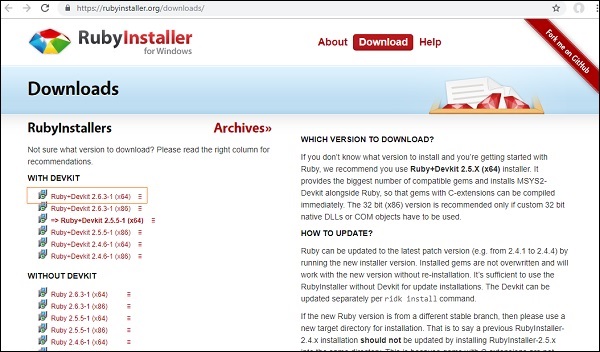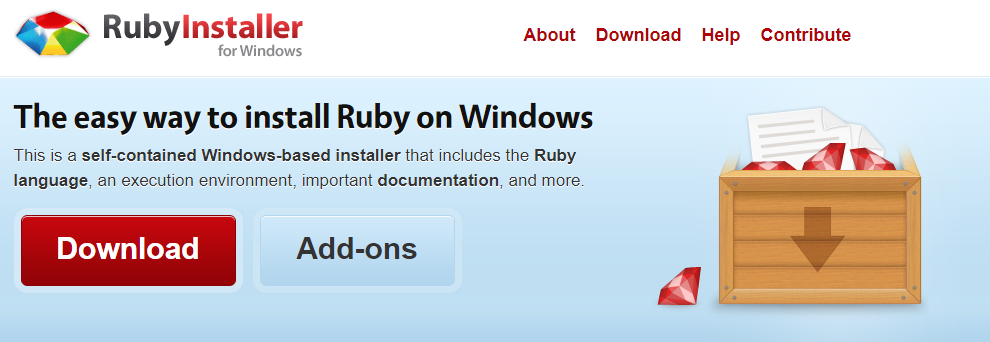

- #RUBYINSTALLER 2.2.4 HOW TO#
- #RUBYINSTALLER 2.2.4 INSTALL#
- #RUBYINSTALLER 2.2.4 GENERATOR#
- #RUBYINSTALLER 2.2.4 PRO#
- #RUBYINSTALLER 2.2.4 DOWNLOAD#
All issues I had with the original script should now be fixed in the files below. REM I am in the repository folder pushd D:\home\site\deployments if not exist tools md tools cd tools if not exist r md r cd r if exist ruby-2.2.4-圆4-mingw32 goto endįinally, I upgraded the version of Ruby to the latest installer (2.2.4). Previously it couldn’t find the tools folder to move into and create the r folder where Ruby will be installed. Secondly, I updated the creation script of the tools folder to be more defensive. Switching to the following fixed this problem. The previous first line of ECHO ON was spitting out each line as if it were a command into the Azure Console output, which didn’t end well for the deployment. The two issues were located in the getruby.cmd file.įirst, I updated line #1 of the command file. I actually started with Scott Hanselman’s example but found a few issues with it.
#RUBYINSTALLER 2.2.4 HOW TO#
If you don’t know how to do deploy via GitHub I recommend this post from Microsoft. This step is pretty simple, and I am not going to rehash it here. To keep our apps consistent, I wanted to figure out how to deploy a Jekyll site from GitHub to Windows Azure App Services (Web Apps). We also utilize Windows Azure for our production environment. to QA then to Prod, which doesn’t fit well on GitHub. We actually host this blog on GitHub pages, but there are other marketing sites we manage that need to go through a more rigorous deployment cycle, Dev.
#RUBYINSTALLER 2.2.4 GENERATOR#
We have chosen Jekyll as our static site generator of choice. Once done and compiled, you can manually copy the gem into your SketchUp “Gems64/gems” folder.As the development team at Ritter Insurance Marketing, we are leaning more on static site generation than ever.
#RUBYINSTALLER 2.2.4 INSTALL#
Afterward, you need to install this gem in the system Ruby environment so the Ruby Dev-Kit can compile it. Normally, you need to install Ruby at the system level (outside of SketchUp, but preferably the same Ruby version.) And then you need to install the Ruby Dev-Kit and follow it’s instructions for getting it setup to work with your system Ruby’s installation. This gem is a binary gem that needs to be complied on the user’s native platform using build tools. The reason for the failure is given in the error message … Error: # ( My Sketchup Pro 2018 version 5 64-bit and sketchup-ruby version is 2.2.4 )īecause, as I said the install command already downloaded the. Since those steps worked without downloading the mentioned files.Īlso, I did not dowload DevKit, since I try to install the suggested precompiled gems) ( I skiped step (1) since I try to access remote server where MYSQL is installed, also, I did not download the gems suggested in step 2, and 3., Still no success, the same error message comes up. Since I could not find any other file there with extension name “.gem”) ( I suspect this is perhaps not the right thing to do with the downloaded file, I have placed it into “C:\Program Files\SketchUp\SketchUp 2018\Tools\RubyStdLib\rubygems” Then I’ve tried to download ODBC binding for Ruby from I fail to succed with step (4), result from SketchUp Ruby Console is: Gem::install "ruby-odbc"Ĭ:/Program Files/SketchUp/SketchUp 2018/Tools/RubyStdLib/rubygems/defaults/operating_system.rb:12:in `rescue in block in 'Ĭ:/Program Files/SketchUp/SketchUp 2018/Tools/RubyStdLib/rubygems/defaults/operating_system.rb:4:in `block in 'Ĭ:/Program Files/SketchUp/SketchUp 2018/Tools/RubyStdLib/rubygems/installer.rb:275:in `call'Ĭ:/Program Files/SketchUp/SketchUp 2018/Tools/RubyStdLib/rubygems/installer.rb:275:in `block in run_pre_install_hooks'Ĭ:/Program Files/SketchUp/SketchUp 2018/Tools/RubyStdLib/rubygems/installer.rb:274:in `each'Ĭ:/Program Files/SketchUp/SketchUp 2018/Tools/RubyStdLib/rubygems/installer.rb:274:in `run_pre_install_hooks'Ĭ:/Program Files/SketchUp/SketchUp 2018/Tools/RubyStdLib/rubygems/installer.rb:235:in `install'Ĭ:/Program Files/SketchUp/SketchUp 2018/Tools/RubyStdLib/rubygems/request_set.rb:166:in `block in install'Ĭ:/Program Files/SketchUp/SketchUp 2018/Tools/RubyStdLib/rubygems/request_set.rb:150:in `each'Ĭ:/Program Files/SketchUp/SketchUp 2018/Tools/RubyStdLib/rubygems/request_set.rb:150:in `install'Ĭ:/Program Files/SketchUp/SketchUp 2018/Tools/RubyStdLib/rubygems/dependency_installer.rb:394:in `install'Ĭ:/Program Files/SketchUp/SketchUp 2018/Tools/RubyStdLib/rubygems.rb:558:in `install' Step (3) works fine, result from SketchUp Ruby Console is: Gem::install "dbi" Step (2) works fine, result from SketchUp Ruby Console is: Gem::install "ruby-mysql" ( I can do that from local Excel to that remote MYSQL database, so I need to connect to remote server from local SU (Pro 2018) to fetch some data required for my scripts.#RUBYINSTALLER 2.2.4 PRO#

#RUBYINSTALLER 2.2.4 DOWNLOAD#



 0 kommentar(er)
0 kommentar(er)
